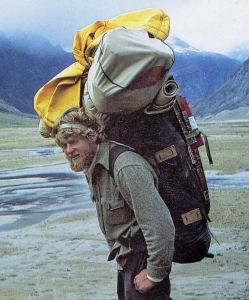
By Phoebe Porter
Conway, Mass.
Carnegie Medal awardee Charles T. Porter, Jr.—known by his family as “Talby” and by the outside world as “Charlie”—led an adventurous life. It was often lonely but was punctuated by moments of intense human contact during rock climbing adventures, ocean trips, and explorations. He was my brother.
Talby’s obituary in The New York Times quoted Duane Raleigh, editor of Rock and Ice, a climbing and mountaineering magazine, as saying that he was “probably one of the great adventurers of the 20th century.”
Born on June 12, 1950, and raised in Pepperell, Mass., Talby was a somewhat solitary child. He preferred building model airplanes in his room and inventing things to playing outside with kids his age. He loved fly-fishing and was tying his own flies from early on. I remember how he set up a telegraph between our bedrooms so we could communicate using Morse Code. At 13, he constructed a canvas-covered canoe that worked perfectly even if it was a bit tippy.
Talby hated formal schooling and did not excel in his classes, but whenever he wanted to learn something, he taught himself. And he learned it well, a pattern that lasted a lifetime. For example, while still in school, Talby developed a passion for rock-climbing, creating his own techniques and equipment. He designed and made his own ice axe, and he invented and made new equipment like rurps, or thin pieces of metal used in climbing.
Although Talby never took lessons in rock-climbing, he developed unusual skill in the sport. It served him well; by 17, he was found by the Hero Fund’s investigator to be “absolutely fearless in mountain climbing” when he helped to save two climbers from exposure after an avalanche on Mount Washington, N.H. He was awarded the Carnegie Medal in 1969 for his role.
During his high school summers, Talby hitchhiked to California, where he was part of the rock-climbing scene in Yosemite National Park. In 1972, he made the first ascent of the Shield on El Capitán with the aid of 35 consecutive rurps. In the early ’70s, Talby became famous for his big-wall routes, establishing the New Dawn and Zodiac ones alone and later three more on El Capitán: Tangerine Trip, Mescalito, and Excalibur.
Other climbs include one on Moose’s Tooth, a peak in Denali National Park, Alaska, where he placed a 20-pound moose antler that he lugged the whole way up. This is just an example of his sense of humor and the light-hearted attitude he took toward mountain climbing. He also made the first solo ascent of the North Face of Mount Asgard on Baffin Island, Canada; the ice climb up the Polar Circus in Banff National Park, also in Canada; and the first solo ascent of the Cassin Ridge on Denali.
By the late ’70s, Talby’s passion for adventure led him to the Andes Mountains and the Patagonia region of South America. He chose to get there on his own by building a sailboat in our parents’ driveway. Although he was a self-taught engineer and boat-builder, my brother did not know a thing about sailing. Somehow he made it from Salem Harbor, accompanied by his wife, to Patagonia, where he spent the last 35 years of his life. Learning as he went, my brother figured out how to sail during that long voyage from New England, through the Panama Canal, and then along the Pacific coast of South America.
Talby settled for a few years on the island of Chiloe and did lots of exploring of the Patagonian archipelago by kayak. In 1979, he was the first person to round Cape Horn in a kayak, through the perilous waters of the Drake Passage. By then he had made his final home in Puerto Williams, the southernmost town with a marina in the world.
During his time in Chile, Talby explored and mapped the complex area of the Patagonian archipelago and got to know the last of the indigenous people who lived there in traditional ways. His extensive study of their languages and knowledge of herbs and plants added to our general knowledge about their culture.
In addition, Talby dedicated himself to studying glaciers, archaeology, botany, zoology, marine biology, and climatology. In 1984 he established the non-profit Patagonia Research Foundation, and he was famous for setting up automated weather stations in isolated places. His wife later told me that the rigors involved in setting up the stations may have contributed to his early death from a heart attack, on Feb. 23, 2014.
After Talby’s death, I visited Puerto Williams and met the people who knew him during the last half on his life. I remember the words of a restaurant owner who knew my brother well and admired him: She repeated, “él no distinguía, no distinguía…,” meaning that he treated all people, from upper or lower ranks of society, in the same kind and frank manner. Perhaps this is his best legacy, that he saw people’s individual worth as equals. Those Chilean friends of my brother whom I met during my visit remembered him with great fondness for being not only an intrepid adventurer, but a fair and decent person.

